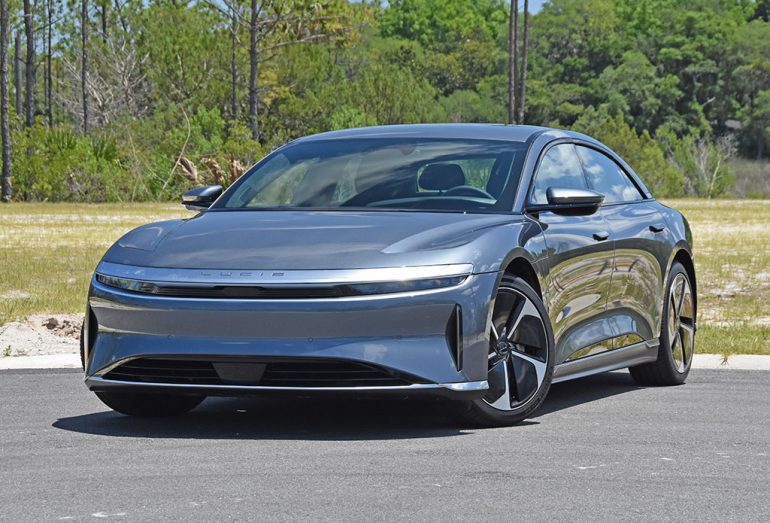
It’s not very often that I get to check out a vehicle that’s produced by a relatively new automaker. In comes Lucid Motors, an American-made newcomer that was actually founded in 2007 as a battery and powertrain maker under the Atieva name and later got its footing out of California as Lucid Motors in 2016 at the helm of Peter Rawlinson, a former VP of engineering at Tesla. In getting to experience the new Lucid Air Pure, the base trim of the new electric luxury sedan, there were some initial low expectations considering the wide gamut of trim levels, a total of four (Pure, Touring, Grand Touring, Sapphire). However, my time with the Lucid Air Pure has proved to be quite a surprising experience residing on the positive side, with the notion always looming in the back of my mind that the Lucid Air is a new automotive maker’s first attempt.
Design-wise, the Lucid Air is unique and nearly on the level of being exotic when you consider the head turns that it demands around town. In my observation, most of those head-turns are out of curiosity, but the stares you get from onlookers are part of the allure that only a really good or really bad design demands – and we’re not talking about the bad side of things like a new Tesla Cybertruck. No, no, the Lucid Air is undeniably a good-looking vehicle fitting the proper mold of being somewhat futuristic and proper for its electric drivetrain. Best of all, the Lucid Air doesn’t follow anything else on the road; it is its own creation that accomplishes amazing feats as a new luxury EV sedan that surpasses much of the competition in many ways.
Also, don’t forget that you can get discounted new car pricing with a free quote through qualified local dealer partners.
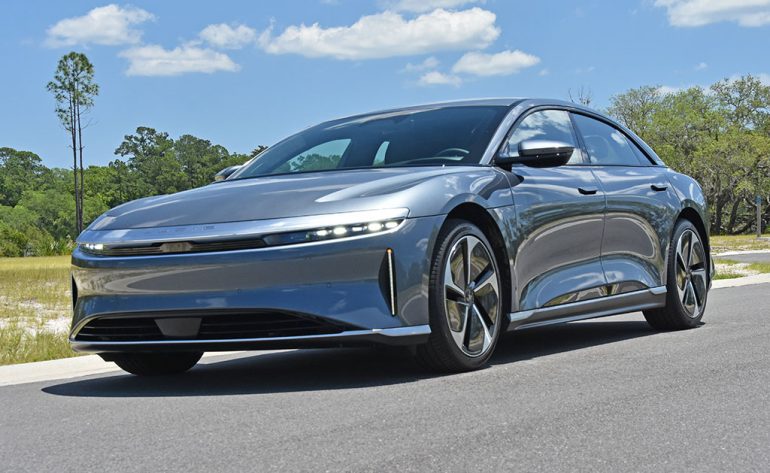
Having a rather unique packaging of the densely powerful electric motor, or electric motors in all-wheel-drive trims, the Lucid Air pushes the envelope for its power and efficiency surpassing most in the EV (electric vehicle) world. In my base Lucid Air Pure RWD test vehicle, you get rear-wheel-drive through a single motor that’s powered by an 88-kWh battery pack. That single motor is good for 430 horsepower and 406 lb-ft of torque, propelling the Lucid Air Pure to 60 mph in about 4.2 seconds.

The acceleration sensation you get out of the Lucid Air Pure is strong but comes on softly out of the hole. The sensation feels as if there are small afterburners that softly kick in after 35 mph, which is a similar experience utilizing the simplistic launch control out of the Sprint drive mode, one of three drive mode settings. Using the default Smooth drive mode somewhat limits power output and sets the standard adaptive dampers on the soft side, but the Air Pure remains nicely planted with no symptoms of sloppy body movement. Moving through the Swift mode, things slightly increase in power output, a heavier steering feel, and added damper firmness. Use of the Sprint mode, the most aggressive setting, feels only marginally more aggressive, which is the mode that I prefer to get the full beans when I want them. In Sprint mode, the adaptive dampers continue to do an excellent job of smoothing out road imperfections but with a slight firmness to the overall ride quality – but not so overly firm that anyone will complain.
The way in which the Lucid Air Pure handles itself is surprising on the side of feeling very buttoned down and stable at all legal speeds and slightly beyond. The chassis dynamics are excellent, and even the turn-in is spot on for what you would expect out of a luxury sports sedan, one that handles exceptionally well for its large size. Immediately driving the Lucid Air Pure, you get a sense of chassis tuning that went above and beyond where it needed to be, making the best use of its low center of gravity, which probably gives way for the out-of-this-world performance you get out of the 1,234-horsepower Lucid Air Sapphire trim. There’s an excellent foundation to build off here!

The downfalls of the drivetrain surround its programming for the regen braking, which only has two modes that both feel rather aggressive but are not technically one-pedal driving modes. Both the Low and Standard braking regen are strong and often enact the brake lights upon nearly letting off the throttle or completely lifting your foot. This is where some work is needed in my view – Lucid could possibly add additional regen levels like Hyundai/Kia/Genesis does with their new EVs, which would make the driving experience much better. Moreover, the creep function is not consistent in its operation and is only enabled when pressing the gas quickly off the brake or actually pressing both the throttle and brake at the same time. In most cases, the Lucid Air Pure will act with a momentary hold, which can be fully enabled for a hold function, or the vehicle will roll back in some cases if the braking hold feature is not set to on.
Overall, the use of the friction brakes, which are surprisingly beefy with 6-piston calipers on 15-inch discs up front and 4-piston rear calipers biting 14.8-inch discs, is mostly a smooth transition from regen braking. Some may find the longer travel of the brake pedal to be a bit disconcerting as the dead area is where the aggressive braking regen technically fills the gap, so the overall transition to the friction brakes is more natural. There’s apparent overengineering here, and I’m all for it!
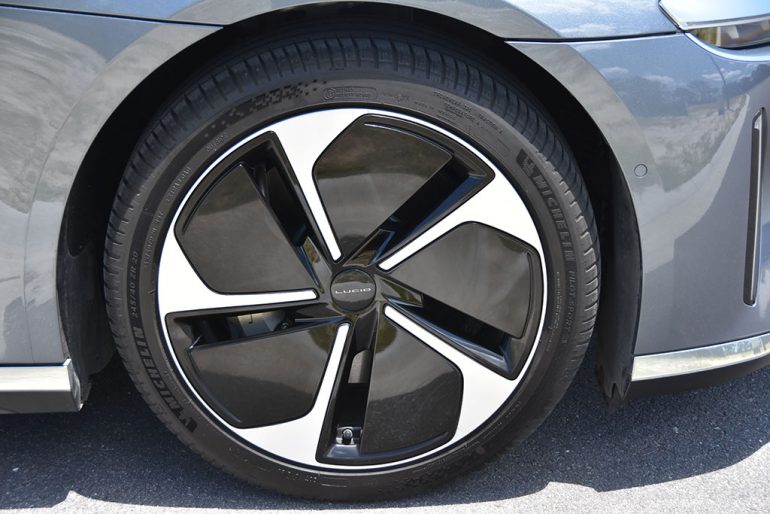
The Lucid Air Pure is the most efficient EV I’ve tested thus far and touts the longest-range estimate at 410 to 425 miles for my Pure RWD trimmed test vehicle. Though, my test vehicle was equipped with the larger 20-inch wheels over the standard 19-inch wheels, range only suffered slightly getting about 390 miles out of a full charge – slightly surpassing the computer estimation of 386 miles after a full charge.
The Lucid Air prides itself on having a long estimated range out of its battery pack, which increases through the trim levels. The Lucid Air Touring gets basically the same range as the Pure with the 19-inch wheels around 425 miles, the Grand Touring gets 516 miles (19-inch wheels), and the performance-oriented 1,234-horsepower Sapphire gets 427 miles. Fundamentally, this is one of the few EVs that calm or somewhat eliminate your range anxiety from having such a long range. That excellent efficiency and range is partly thanks to a slippery 0.197 coefficient of drag.

Charging up the 88-kWh battery pack takes place quickly using a DC fast charger that nearly matches the claimed 17 minutes to charge to 200 miles of range from a mostly depleted battery. During my test at an Electrify America 350-kW DC fast charger from a range of 120 miles left, I was able to add 135 miles of range in 15 minutes. When the range reached just over 300 miles while charging, the charge rate started to drop drastically. Moreover, I only peaked during the charge session at 135kW, which I somewhat attribute to the Electrify America station being worked on at the time by a tech. Lucid claims a max charge rate of 200kW.
As far as utilization, the Lucid Air Pure averaged about 4 kWh per mile in mixed highway and city driving, which mostly matches the EPA combined estimate of 137 MPGe (140 MPGe city/134 MPGe highway). I did see figures as high as 4.6 kWh per mile on lower-speed highways over the course of a 20-mile drive, which is nearly 158 MPGe.
The cabin space of the Lucid Air is very airy, pun intended. There’s a good amount of room for all passengers, exuding the feeling of a proper full-size luxury sedan. The seats are comfy, but the front heated seats lack any adjustment for the headrests for the base Pure trim, even though they are on the large and soft side. Taller individuals will need to be mindful of the sloping roofline and keep tabs on their seat height adjustment, as there’s a limited amount of headroom. The standard 12-way power-adjustable front seats can be upgraded through an option to have 14-way or 20-way adjustments, ventilation, and massage functions. The rear seats have good space as well, and there is the option of heated outboard seats. Cargo space is generous considering there is a very deep frunk (front trunk) and the use of the nearly-level floor of the rear trunk accessed by a powered clamshell-like liftgate.
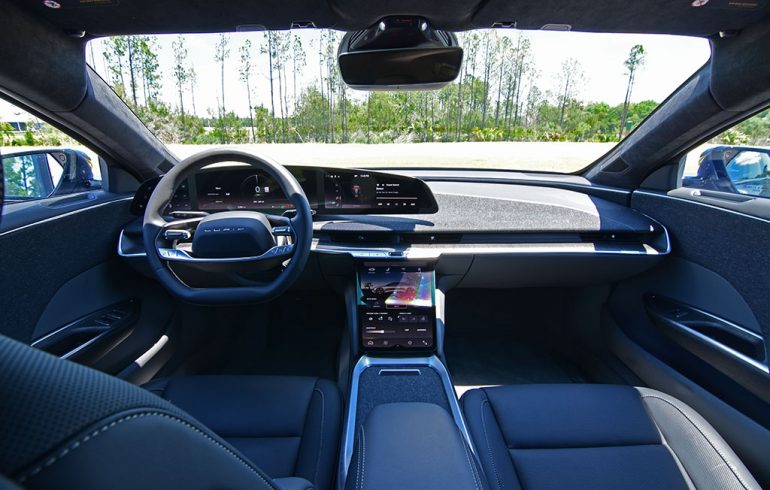
The Lucid Air lacks any physical start/stop button, leaving the vehicle startup automated by pressing the brake pedal upon entering the vehicle. Shutting down the vehicle is left to just hopping out and locking the doors, which can be done through the key fob, pressing the motorized door handles, or setting the passive locking feature where it will lock by simply walking away with the key fob in your pocket. The Lucid Air Pure can be optioned with the optional soft-close doors.

When you get ready to charge the vehicle, you must press a button on the left of the floating gauge cluster to open the power charge port door, as there is no opening button access outside of the vehicle. Speaking of the floating cluster, the instrument/infotainment screen and gauge cluster are integrated into a curved floating 34-inch screen pod. The infotainment touchscreen portion of the pod is somewhat on the small side, where it delicately integrates wireless or USB-connected Apple CarPlay and has a steep learning curve for navigating its functions. Currently, Android Auto is not available on the Lucid Air.
While the functions are seemingly simple, you don’t realize the simplicity until you overcome a long learning curve that may take a couple of days to master. Part of that experience involves the use of the larger, lower power-retractable touchscreen, which to some may seem more like a novelty but is essential for controlling essential features. The lower center console touchscreen serves as a center for vehicle functions and controls, as well as the three-zone automatic climate control center. Some functions from the upper touchscreen can be swiped down onto the lower screen, which is a neat party trick, just as the screen’s ability to motor out of the way into the dashboard to reveal a large console storage area.
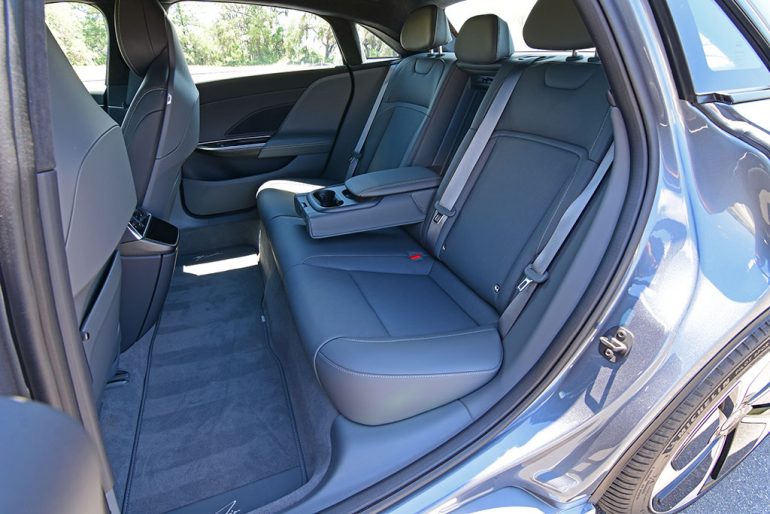
Overall, there’s a lot to appreciate in the uniqueness of the Lucid Air’s dashboard layout, which is also accompanied by a luxurious feeling throughout with soft-touch surfaces everywhere and a nice touch of padded fabric trim. Even the lower door trim is all soft-touch materials accented by small strips of metal-looking trim. Though, I must mention the annoying trait of the bright glare you get from the small polished-finished strip of physical climate controls that also encase the volume rocker knob, in addition to the cupholders being a bit too small for many containers.

There’s the typical group of active safety features included on the Lucid Air Pure, which include lane departure warning/mitigation, forward collision warning/emergency braking, blind-spot monitors, adaptive cruise control with speed limit sign adaptation, rear cross-path detection/emergency braking, and driver attention warning. In place of the Lucid Air Pure’s standard single rear camera angle setup, you can get the option for the 3D surround view monitor and a future-capable (ADAS) advanced driver assistance system (semi-autonomous driving).
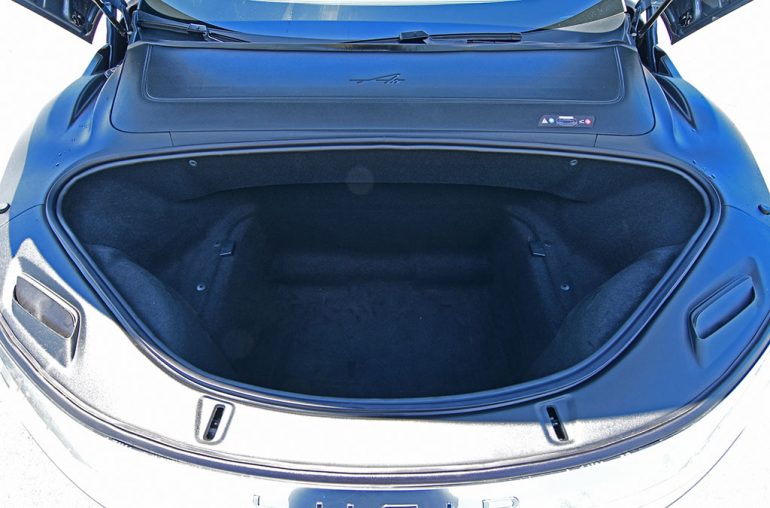
The base Lucid Air Pure without any options is seemingly a good value for the collective of its parts and features and having an exceptional EV range of just over 400 miles. Starting at $69,900 before any fees is an attractive proposition after I had a chance to experience all that the Lucid Air Pure has to offer in its no-option form apart from the larger 20-inch wheels and attractive Fathom Blue Metallic paint option.
I have high hopes for the Lucid Motors brand and look forward to seeing their Gravity SUV make its debut in the many months to come to hopefully set the company in the green because the Lucid Air Pure is a remarkable start at the as-tested price of $72,200.